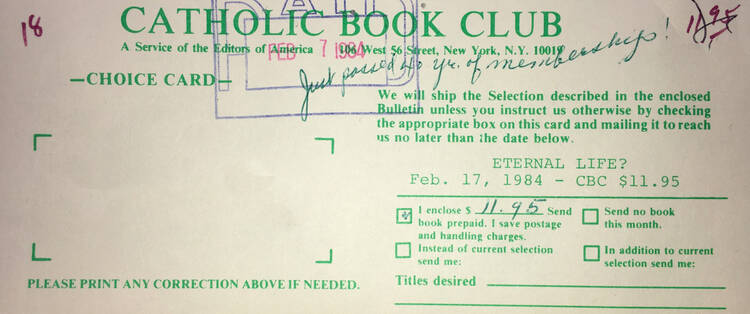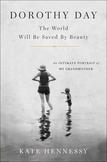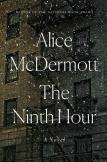Ninety years later, the Catholic Book Club gets a makeover.
Ninety years ago this month, the literary editor of America, Francis X. Talbot, S.J., announced the formal incorporation of the Catholic Book Club. Originally intended as a competitor to secular book clubs like the Book-of-the-Month Club and the Literary Guild, the Catholic Book Club used a direct-mail model, and the inaugural edition of the C.B.C. newsletter (October 1928) announced the club’s first selection: The Way It Was With Them, a novel by Peadar O’Donnell set in a fishing village in the west of Ireland. In a 1959 retrospective in America on the legacy of the Catholic Book Club, the literary editor Harold C. Gardiner, S.J., reflected on its original rationale:
It was not a question so much of fearing that morally unacceptable books would be chosen as that any specifically Catholic reading interest would simply be overlooked. There were Catholic readers looking for such books and there were Catholic books: why not, then, bring them together?
The fortunes of the Catholic Book Club waxed and waned over the ensuing decades, with membership falling below 1,000 in the postwar era but rising to almost 8,000 members by the 1960s. The club also went through various business models, sometimes offering books mailed directly from America Press and at other times simply issuing recommendations and suggestions to members. Here is Father Gardiner again, from 1959:
It will, in all likelihood, never match in membership the millions enrolled in the various “condensed book” clubs, just as America itself, whose apostolate of the written word the CBC seconds and broadens, will never be another Reader’s Digest.
But Father Gardiner probably never envisioned the literary marketplace of the United States in 2018. Those “condensed book” clubs have had a rough go of it, with even Reader’s Digest reporting yearly operating losses and filing for bankruptcy twice in the past decade. Is there even an audience, we asked ourselves at America in the summer of 2017, for high-quality, edifying literature, or for a literary club that might seek to join together (literally or virtually) to discuss such books?
The answer has been a resounding yes. We relaunched the Catholic Book Club in September 2017 with a new format, whereby our moderator, Kevin C. Spinale, S.J., picks four books a year in conjunction with our editorial staff, then works with the staff to provide questions for discussion, supporting materials, conversation prompts and more to members. These resources are available online free to all members. Discussions of each book also now take place onlin, through a Facebook group page where members can post questions, comment on one another’s insights and offer general commentary. And we were happy to find an eager audience. By the end of August we had several hundred members; by the beginning of February we had over 1,000.
We relaunched the Catholic Book Club in September 2017. By the end of August we had several hundred members; by the beginning of February we had over 1,000.
Dorothy Day: The World Will Be Saved by Beauty
Our first selection was a memoir by Kate Hennessy, granddaughter of Dorothy Day, the founder of the Catholic Worker who is now on the path to sainthood in the Catholic Church. Dorothy Day: The World Will Be Saved by Beauty includes many elements of standard biography, as it tells the story of Dorothy Day’s life and of the founding (and quotidian realities) of the Catholic Worker, but Father Spinale located the crux of the book in its elements of memoir. Dorothy Day’s daughter, Tamar (Kate Hennessy’s mother), plays an important role in the book, particularly in Hennessy’s remembrances of her own childhood. “The relationship between Tamar and Dorothy is really the heart and soul of this book,” Father Spinale commented in America. “Dorothy’s immersion into poverty and its ugliness shapes Tamar’s life and the life of Tamar’s nine children.”
Some members admitted in the discussion forums that they found Dorothy Day a puzzling, even troubling figure, particularly in her relationship with Tamar. A number of readers found illuminating Hennessy’s suggestion that “Tamar was looking at the Church through hard-eyed practicality forged, stripped, and scrubbed clean by teachings that dogged her every step as a child, teenager, and childbearing woman, whereas Dorothy experienced the Church as only a mystic can—free of its corruption.” Another common theme in discussions was the way we define saints, or holiness, reminding many readers of Dorothy Day’s own comment: “Don’t call me a saint; I don’t want to be dismissed so easily.”
The Ninth Hour
Our second selection was a novel by Alice McDermott, the well-known chronicler of Irish American urban and suburban life in her many novels and short stories. In The Ninth Hour, McDermott’s subject matter is Brooklyn in the 1920s, focusing on a convent of religious sisters whose quest for everyday holiness and devotion to their duty resembles that of Dorothy Day in many ways. The sisters are the heroes of the neighborhood—far more than the priests are—and a source of comfort and grace in the hard lives of their immigrant neighbors.
“I cannot recommend reading this novel enough,” Father Spinale commented in his essay on the novel, “and rereading it as well. It will provoke contemplation and prayer. It is a Catholic book, and it will seep into you like indigo into a clean, pure bolt of cloth.”
Some readers found the life of the nuns in their convent unexpectedly drab and joyless, and asked if McDermott had played up the colorlessness of daily routines in a convent of sisters working among the poor—or was that just the reality of life for many of the sisters? Several also mentioned McDermott’s description of the sisters’ habits as striking: “The white horse-blinder bonnets they wore did more than limit their peripheral vision. They reminded the Sisters to look only at the work at hand.” The novel also included some surprising plot turns and unexpected revelations, to the extent that a number of readers noted that when they finished the book, they agreed with Father Spinale that “I need to read this again from the beginning.”
What’s Next?
In recent weeks the Catholic Book Club has begun to discuss our third selection, a more academic but also spirituality rich selection: Gerhard Lohfink’s Jesus of Nazareth: Who He Was And What He Stood For. We will soon select the fourth book in our yearly cycle, likely a political biography so as to satisfy the different interests of our readers and also offer the broadest possible range of quality books with spiritual and intellectual heft.
For readers who are interested in joining the Catholic Book Club, visit https://www.americamagazine.org/catholic-book-club. Join on your phone...and then put your phone away and start reading the books!
This article also appeared in print, under the headline “Ninety Years Later, the Catholic Book Club Gets a Makeover,” in the Spring Literary Review 2018, issue.











